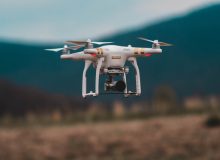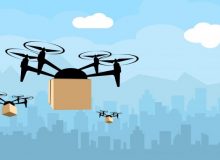The drones are “remotely piloted aircraft” (APR), that is, flying devices that do not have any pilot on board , ie they are piloted by an on-board computer or by a pilot who drives them remotely with a remote control. They are also classified as remote piloted systems ( SAPR ).
In a slightly approximate way we could say that they are the technological evolution of remote-controlled airplanes, even if in reality they are something much more sophisticated and, as we will see in the next paragraphs, they are technologically very advanced objects that can be used in professional contexts and on long distances, these characteristics that already distinguish them from the “old” radio-controlled airplanes.
In principle, they are “flying objects” which, through a small motor, have the ability to fly in open spaces and allow different types of operations to be carried out, such as taking photographs or carrying small weights. The fact, however, that they are identified as aircraft (even with remote pilotage) immediately makes it clear that, regardless of the position of the pilot or flight crew, the operations must comply with the same rules and procedures as the piloted aircraft.
APR, a remotely piloted aircraft, is the Italian acronym by which we now commonly identify drones but often other terms and acronyms are also used such as RPA (Remotely Piloted Aircraft) , RPV (Remotely Piloted Vehicle) , ROA (Remotely Operated Aircraft) but they can also be referred to as UAV (Unmanned Aerial Vehicle) or UVS (Unmanned Vehicle System) .
Usually they have a structure made of light materials, so that they can fly without any complication, and a battery that powers the drones themselves, which allows the propellers to move and therefore provide the drone necessary force to take flight.
They are available in different variants and versions, each of which adapts to a specific purpose. have different applications depending on their operation and their characteristics.
How do they work
Some types of drones are controlled with an app on the tablet, installed on the smartphone or on the computer, while others are controlled by a remote control similar to the one designed for a console for video games. Before losing the controller signal, professional systems can reach up to 2 kilometers away, while the figure is decidedly lower for the lower quality types. Similar considerations can also be made for autonomy: in general they can fly for a few minutes (15-20 for medium-low range drones), but the flight duration of a professional drone can even reach 1 hour.
The drones operate mainly in two ways :
- driven by radio control which allows the drone to be driven in real time by a pilot
- unmanned , in this case they carry out their task independently (after programming the “on-board computer” or with a remote control via software)
In the first case we talk about RPA -Remotely Piloted Aircraft , the most common type of drone with regard to personal use, consumer type. These are systems equipped with radio controls thanks to which the drone will be piloted in real time; these drones allow you to carry out some basic activities such as video shooting from above. However, these are drones that need a certain level of practice in order to be used in the best way, since initially it could be complex to let them fly and to ensure that the air currents do not have a negative repercussion on the drone itself.
In the second case, instead, we are talking about a typology known as UAV – Unmanned Aerial Vehicle : in this case we speak of systems that cannot be piloted and that will independently carry out the different operations during the flight. These must be set prior to their use so that it is possible to exploit the drone according to those particular needs for which it will be “programmed”. For example, to perform the resumption of an event, it will be possible to set the flight height, stabilize the drone and choose the different angles before the event to then activate the same settings and let the drone operate autonomously.






